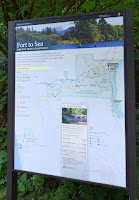Learn
About the Maritime History of the Pacific Northwest in Astoria, Oregon.Astoria, Oregon, is located near the mouth of the Columbia River that creates the border between the states of Washington and Oregon. Astoria,
the oldest city in Oregon, is an interesting and fun place to visit. Anyone who
is on a Lewis and Clark pilgrimage is going to stay there of course. But there
is a rich history about this town that goes way beyond the Corps of Discovery.
The
Lewis and Clark Expedition spent the winter of 1805-06 at Fort Clatsop that they built just four miles to the southwest of modern-day
Astoria. In 1811 fur trappers of the American Fur Company, owned by John Jacob
Astor, established Fort Astoria where the city is today. Astoria is a deep-water
port whose location on the Pacific coast made it a thriving resource town since
then. Along with the fur industry, there is the timber industry and fish canneries for processing
locally caught salmon. As you can imagine, not only the shipping of these
commodities but the fishing industry as well creates a strong maritime history
in Astoria. Oh, yes, and do not forget
the Columbia bar.
Those of you not familiar with the area might be asking what
the Columbia bar is exactly. Well, as the Columbia flows over 1200 miles all
the way from Canada to the Pacific, it picks up sediment, as most rivers tend
to do. As the waters of the Columbia hit the Pacific Ocean, it slows. When it
does it drops the sediment creating what they call a “bar.” The Columbia Bar is
an area about 3 miles wide and 6 miles long where the river enters the ocean.
Because the bar creates shallows, the waters there tend to be rough and prone to
a lot of unusual waves and currents. Plus, the sediment in the bar is always
shifting around. That’s why large container ships need a river pilot to guide
them into port. Moreover, combine the dangers of the bar with the naturally
crappy weather of the Pacific Northwest and you’ve got some challenges. There
are so many shipwrecks historically around this area (over 2,000 since 1792) that
it has earned the nickname of the “
Graveyard of the Pacific.”
This is where
the Columbia River Maritime Museum comes in.
This is a must-see when you visit Astoria. Most of the exhibits are indoors so
don’t worry about the weather (oh, yeah, it rains a lot in Astoria). We made
our trip pre-covid, but despite the pandemic, the museum is open with
protocols. You will see exhibits on each of the industries that are a part of
the history of this area. Particularly interesting to me is the information
about the bar. Such a historically dangerous spot that had to be conquered
(still true today) in order to exploit the resources of this region and on an
individual level, earn a living. You’ll learn what a “bar pilot” does, and that
there are only about 16 of these specialists working out of Astoria today.
There is also a fine exhibit honoring the work of the
United States Coast Guard in and around the Columbia River Bar.
When we visited Astoria, we stayed at
the River Walk Inn,
one of several hotels that provide a view of the marina from your room (nice!). From
the hotel, you are able to
catch a trolley that runs the length of the city with
a stop at the Maritime Museum. The entry fee is a little pricey at $16 for
adults, but that’s probably because I think all museums should be free. Regardless,
the museum is worth it. Add it to your itinerary along with your
pilgrimage to Fort Clatsop.
For more information, visit the Columbia River Maritime Museum website.



















